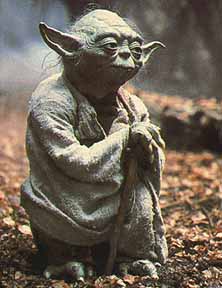 The making of Yoda,
Part III
The making of Yoda,
Part IIIRead part I and part II before this........ Ergo
Nick Maley continues his insights into the creation of Yoda with the third file in the series ......
 The making of Yoda,
Part III
The making of Yoda,
Part III
Read part I and part II before this........ Ergo
Ergo: You ended part II saying that there was a fourth version of Yoda.
Nick: Yes.
Ergo: Was that made for specific purpose too?
Nick: No. You'll remember that I mentioned before that Ron Hone built two versions of the rc Yoda mechanism. The second was a form of insurance against any problems arising with the first mechanism.
Ergo: ....but the second was never needed?
Nick: That's right. Never-the-less the principle of having a back-up was welcomed by Lucasfilm.
 As we
got closer to Yoda shooting, Stuart
(Freeborn), was looking more and more harassed. The first
few days of Yoda's hut were very
difficult. (When Episode I came was released, Mark Hamill
had some web pages on line. You may have read his recollection of
sitting around on Degoba waiting for Yoda
to be fixed... For the first week of shooting the Stuart,s
puppet broke down a lot). The long weeks Stuart had spent locking
down the modeling (at one time there were 4 versions in progress
simultaneously) had left Stuart with less time than he would have
liked to complete his mechanism the way he wanted. The compromises he
was forced to make meant that the mechanism was less effective than
he knew it was capable of.
As we
got closer to Yoda shooting, Stuart
(Freeborn), was looking more and more harassed. The first
few days of Yoda's hut were very
difficult. (When Episode I came was released, Mark Hamill
had some web pages on line. You may have read his recollection of
sitting around on Degoba waiting for Yoda
to be fixed... For the first week of shooting the Stuart,s
puppet broke down a lot). The long weeks Stuart had spent locking
down the modeling (at one time there were 4 versions in progress
simultaneously) had left Stuart with less time than he would have
liked to complete his mechanism the way he wanted. The compromises he
was forced to make meant that the mechanism was less effective than
he knew it was capable of.
The production office were pushing to see a back-up head built but Stuart was exhausted... often working through the night to fix the original puppet. Since I had already completed two minor versions of Yoda, Bruce Sharman wanted me to assemble a "Stand-by" Yoda puppet head. He gave us a deadline of 3 days.
Ergo: 3 days! ???
Nick: He wasn't asking for full movement..... he just wanted a little insurance against delays in shooting. The goal was AT MINIMUM to build a Yoda that could be shot from behind, over Yoda's shoulder onto Luke, with ear movement. But he said that any other movement in the puppet would be a bonus. Stuart wanted extra time to sort out the teething problems with the initial puppet so he agreed and Bob Keen and I started on the Stand-by Yoda immediately. It was 4.00 pm when we were assigned this task and we didn't go home until it was finished three days and nights later.
Our approach was radically different to Stuart's. Stu was seeking perfection. He machined special linkages and designed a uniquely original mechanism. We on the other hand took all the discarded mechanisms, spare skins and skulls and amalgamated them into the best hybrid puppet that could be built in the time....... out of whatever was lying around... and some cables that I bought from the local bicycle shop
Ergo: Sounds pretty hit and miss.
Nick: It was certainly risky, but Stuart had made sure that the workshop was well equipped. I adopted Bob Keen to help me just as Stuart had adopted Nick Dudman. We made a good team. As I fitted and hollowed out the skull he checked that the mechanism we were adapting was operational. As he fitted the basic mech to the skull, I eased the interior of the skin to allow greater flexibility. We both labored long over finding the best routing for the cables and occasionally we took a quick nap on the floor under the work bench.
Ergo: So you didn't go home?
Nick: There was no time. We worked 60 hours straight through to the beginning of shooting and then hung around a full day in case any problems arose. In many ways we were establishing a pattern that we would repeat on many other movies as Bob proceeded to assist me as my #2 for the following 5 years. We complemented each other well. Where as I was more artistic than he was (and, at that time, had a better understanding of the materials we were using), Bob's model making background made him better at assembling and connecting the mechanism that I had designed from the various scraps we had located.
Ergo: Sounds like he was really useful.
Nick: Neither of us could have done it in the time without the other.
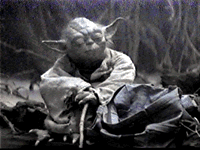 We
adapted one of Stuart's earliest eye mechanisms, abandoning the
complicated linkages that were causing Stuart's headaches and
reverted to direct cable runs utilizing long gentle curves that
spiraled inside the head to minimize friction. Reverting to direct
cables meant there was more room inside and that made it easier to
facilitate the movement of Frank Oz's
hand as it passed up from the mouth to operate the eyebrows. A series
of rubber cups were located in key areas around the mouth and
eyebrows for Frank's fingers to easily locate precise points and in
the final analysis it was his great performance that convinced the
audience that Yoda lived.
We
adapted one of Stuart's earliest eye mechanisms, abandoning the
complicated linkages that were causing Stuart's headaches and
reverted to direct cable runs utilizing long gentle curves that
spiraled inside the head to minimize friction. Reverting to direct
cables meant there was more room inside and that made it easier to
facilitate the movement of Frank Oz's
hand as it passed up from the mouth to operate the eyebrows. A series
of rubber cups were located in key areas around the mouth and
eyebrows for Frank's fingers to easily locate precise points and in
the final analysis it was his great performance that convinced the
audience that Yoda lived.
Ergo: It must have been very difficult to devise such cutting edge stuff with so little sleep.
Nick: The adrenalin kept us going.... but you're right. We got pretty spaced out.... and it was after our second night without sleep that the wacky incident I related in Yoda, the Nogard's sacrifice, and the guy we nailed to the floor! took place.
Ergo: That was awesome!
Nick: It was nerve wracking. Anyway, as we went into the third night Graham Freeborn stayed late to complete the hair punching and we artworked the skin long before it was fitted to the mechanism.
Ergo: Is that normal?
Nick: Not really but we had no choice. I knew that if we waited until the mechanism was complete and the skull was finished that we wouldn't complete in time to shoot the next day. I was determined not to go beyond the deadline I had agreed.
Ergo: When you think of epic movies like STAR WARS you think that everything must be built and tested weeks before filming. I guess that's not always the case.
Nick: It is often not the case, especially if what you are building is something you've never done before.
Ergo: Is that common?
Nick: It was for me. I built my career on breaking new ground in ridiculously short time frames on almost every movie.
Ergo: Particularly on KRULL.right?
Nick: KRULL, LIFEFORCE, HIGHLANDER... most of them.
 Getting back to Yoda, Bob
soldered up the last linkages and then he slept on the floor for a
few hours while I fitted the skin. When I was finally finished we had
less than 4 hours left to dress the hair and touch up the artwork but
despite that, it took me a full half hour to work up the courage to
test the mechanism. Bruce had only asked that the ears work, but we
had gone for a full working puppet... eyes left,right, up and down
plus upper and lower eyelids, ears.... and with the full mobility
that Frank had asked for. We were not sure that it would still work
with the skin attached. I felt like so much was riding on it and I
didn't want to discover that it didn't function properly. I woke Bob
and we made a cup of tea..... then took a deep breath and tried out
the mechanism. It was stiffer than we would have liked but we were
totally elated to see that that we got full movement from it.
Getting back to Yoda, Bob
soldered up the last linkages and then he slept on the floor for a
few hours while I fitted the skin. When I was finally finished we had
less than 4 hours left to dress the hair and touch up the artwork but
despite that, it took me a full half hour to work up the courage to
test the mechanism. Bruce had only asked that the ears work, but we
had gone for a full working puppet... eyes left,right, up and down
plus upper and lower eyelids, ears.... and with the full mobility
that Frank had asked for. We were not sure that it would still work
with the skin attached. I felt like so much was riding on it and I
didn't want to discover that it didn't function properly. I woke Bob
and we made a cup of tea..... then took a deep breath and tried out
the mechanism. It was stiffer than we would have liked but we were
totally elated to see that that we got full movement from it.
Ergo: It must have been a magical moment.
Nick: It was a natural high. Of course in later years we did so much more complicated stuff that now it seems incredible that we could have had such brain ache over things we take for granted. At the time it was stuff we had never done before.
Ergo: Was the Stand-by Yoda used?
Nick: It was used extensively. Getting it on the set meant that Stuart could recall the first puppet and had the time to make the revisions that he needed.
Ergo: There was so much expression in Yoda's eyes, a lot of people thought that there was someone inside it.
Nick: I know. But the "humanity" in Yoda's performance came from the sensitive performance of Frank and his puppeteers.
Ergo: Tell me about Yoda's ears..... they moved superbly.
Nick: They were pretty good..... but I can't take the credit. I had watched Wendy Midner fit a brilliantly simple mechanism to the ears of the first Yoda head and I emulated that design. It didn't work quite as well but hey..... we built the whole thing in three days.... (I suspect she probably made adjustments when she had the Stand-by Yoda on set).
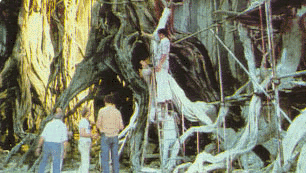 Ergo: I've seen photos of the Dagobah set that housed Yoda and his hut. It looks huge.
Ergo: I've seen photos of the Dagobah set that housed Yoda and his hut. It looks huge.
Nick: It was very impressive.
Ergo: They made those trees out of plaster I read somewhere.
Nick: They did a great job. Even standing in the middle of the set it was hard not to think you were in a swamp. They had a stream that ran through the set into the pond where the X-Wing had crashed and we used to wade through the mud and cross the stream via a few wooden planks.
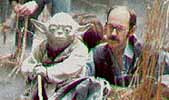 Ergo: That was real mud?
Ergo: That was real mud?
Nick: The crew would wade around in Wellington boots and poor Frank Oz spent half his time lying in it.
Ergo: I thought if they made plaster trees then they would use some kind of clean mud.
Nick: Afraid not. In fact the dirt took only a couple of
days to migrate to Yoda's face.
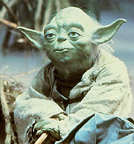 Frank and his operators did their best to keep the
puppet clean but there was only so much that they could do. I'm sure
you know that they don't shoot movies in sequence. If you look at the
film really carefully you can tell which shots were first and which
were filmed last just by how grubby Yoda's face is.
Frank and his operators did their best to keep the
puppet clean but there was only so much that they could do. I'm sure
you know that they don't shoot movies in sequence. If you look at the
film really carefully you can tell which shots were first and which
were filmed last just by how grubby Yoda's face is.
Ergo: You're kidding me?.
Nick: Take a look. It's really obvious to a discerning eye.
Ergo: Yoda is a real movie icon, a creature that stands out from the rest. When did you know that you had helped create something special?
Nick: I got excited the first time I saw what we had built in close-up at rushes. But the real buzz was to sit in the audience of a public screening and listen to the audience react to this lump of inanimate materials that we had assembled. That was the ultimate accolade for me, and of course Stuart got a well earned BAFTA award.